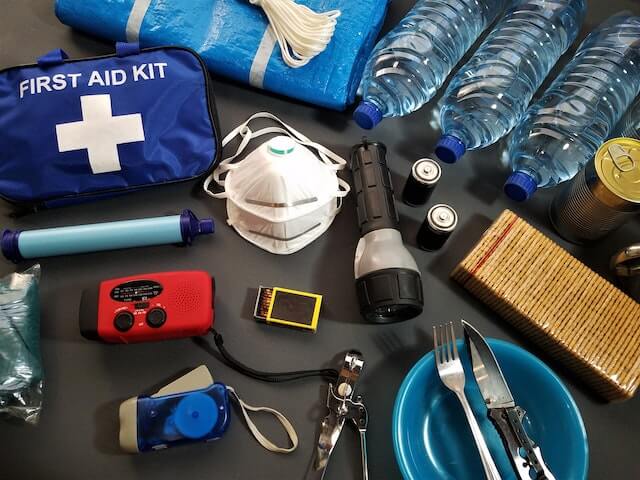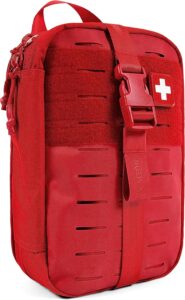Accidents and emergencies can happen at any time and in any place. Whether at home, on a camping trip, or simply going about your daily routine, having a well-equipped first aid kit can make a significant difference in handling minor injuries or potentially life-threatening situations. The question often arises: should you build a first aid kit or buy a premade kit? In this article, we’ll explore the pros and cons of both options, discuss the essential items that should be included in any first aid kit, and provide our recommendations for premade first aid kits.
Building Your Own First Aid Kit
Many people choose to piece together their first aid kit to personalize it and include extra items they may need. I’ve made plenty of specialized first-aid kits for different activities and trips. You never know what you will need and can’t bring everything with you, but you can get as close as possible if you plan it out.

Pros of Building Your Kit
Customization: One of the primary advantages of assembling your first aid kit is the ability to customize it to your needs. You can tailor the kit to the activities you frequently engage in, ensuring you have the right supplies for your lifestyle.
Cost-Effective: Building your kit from scratch allows you to choose cost-effective options for each item, potentially saving you money compared to buying a premade kit.
Knowledge and Familiarity: Selecting items for your kit can enhance your knowledge of first aid essentials and how to use them. You’ll become more familiar with the contents, which can be crucial in high-stress situations.
Quality Control: When you build your kit, you have control over the quality of the components. You can select trusted brands and ensure everything in your kit meets your standards.
I have included a list of items you should always have in your first-aid kit at the bottom of this post.
Cons of Building Your Kit
Time-Consuming: Customization takes time and effort. You need to research, purchase, and organize each item. This process may not be suitable for those needing a quick first aid kit.
Risk of Omission: There’s a risk of forgetting important items or underestimating the requirements of a specific situation, especially if you need more medical expertise.
Limited Guidance: If you’re not a medical professional, you may lack the guidance and expertise to select the most appropriate supplies for your kit.
Buying a Premade First Aid Kit
Not everyone has the knowledge or time to put together their kit. Buying a premade first aid kit or 72-hour kit is a great way to ensure you have the basics and can help when you’re low on time and need something quick.
Pros of Buying a Premade Kit
Convenience: Premade first aid kits offer a hassle-free and time-saving solution. They come pre-assembled and ready to use, making them ideal for busy individuals and families.
Comprehensive: Many premade kits are designed by experts, ensuring they contain a comprehensive selection of items suitable for various emergencies.
Expert Guidance: These kits are often created with input from medical professionals, ensuring they include essential items and instructions.
Portability: Premade kits are usually compact and easy to carry, making them suitable for outdoor activities, travel, or keeping in your car.
You Can Add To It: You can always buy a premade kit and add specialized items if there is extra room.
Cons of Buying a Premade Kit
Limited Customization: Premade kits may not offer the customization you can achieve when building your kit. They might include items you don’t need or lack items that are essential for your specific needs.
Potentially Higher Cost: Premade kits can be more expensive than building your own, as you pay for the convenience and pre-selected contents.
I’ve carried numerous first aid kits across the country multiple times, both premade and DIY. MyMedic first aid kits are one of my top choices if I need a comprehensive one and don’t want to go through the process of piecing together my own.
The decision to build your first aid kit or buy a premade one depends on your specific needs and preferences. Making your kit allows for customization and cost savings but can be time-consuming and may lack expert guidance. On the other hand, premade kits like those offered by MyMedic provide convenience, specialist design, and a comprehensive selection of items, but they may come at a slightly higher cost. Ultimately, the choice comes down to your priorities and the level of preparation you seek.
Remember that having any first aid kit is better than having none. It’s crucial to be prepared for unexpected emergencies. Whether you decide to build your own or invest in a premade kit, the important thing is to have the right tools and knowledge to respond effectively when needed.
Our First Aid Kit Recommendations:
My Medic First Aid Kits
For those who value convenience and quality, My Medic offers a range of premade first-aid kits that stand out. They are designed to meet the needs of various situations and activities, from everyday first aid to outdoor adventures. Some key features of My Medic first aid kits include:
Expert-Designed: My Medic kits are created with input from medical professionals, ensuring they contain the right supplies for everyday emergencies.
Customization: My Medic offers a range of kits designed for different purposes, such as home use, travel, or outdoor activities. This allows you to select a kit that suits your specific needs.
Quality Components: My Medic kits contain high-quality supplies from trusted brands, ensuring that you have reliable tools.
Compact and Portable: These kits are designed to be lightweight and portable, making them easy to carry with you wherever you go.
Instructional Resources: My Medic kits often include instructional materials, such as first aid manuals and online resources, to help you use the kit effectively.
Items You Should Have in Your DIY First-Aid Kit:
If you decide to build your first aid kit, it’s essential to include the following items:
- Adhesive Bandages: Various sizes for covering minor cuts and wounds.
- Sterile Gauze Pads and Rolls: To dress more significant wounds.
- Adhesive Tape: For securing bandages and dressings.
- Antiseptic Wipes: To clean wounds and prevent infection.
- Scissors and Tweezers: For cutting tape, clothing, or removing splinters.
- Cotton Balls and Swabs: Useful for cleaning and applying ointments.
- Pain Relievers: Over-the-counter pain medications for pain relief.
- Thermometer: To monitor body temperature.
- CPR Face Shield or Mask: For performing CPR safely.
- Disposable Gloves: To protect yourself and others during first aid procedures.
- First Aid Manual: A reference guide for basic first aid procedures.
- Emergency Contact Information: Include important phone numbers, allergies, and medical conditions.
- Blanket: To keep injured individuals warm.
- Tweezers: For removing splinters or foreign objects from wounds.
- Burn Cream or Gel: For treating minor burns and scalds.
- EpiPen: If you or someone in your family has severe allergies, having an epinephrine auto-injector can be life-saving in case of an allergic reaction.
- Prescription Medications: If you or a family member takes prescription medications regularly, keeping a small supply in your first aid kit in case of emergencies is a good idea.
- Allergy Medication: Over-the-counter antihistamines can help manage allergic reactions to insect stings, pollen, or other allergens.
- Aspirin: Aspirin can be helpful during a heart attack to reduce blood clot formation. However, it should only be administered under the guidance of a healthcare professional.
- Antacids: These can provide relief from heartburn or indigestion.
- Eye Wash Solution: Useful for rinsing foreign objects or irritants out of the eyes.
- Instant Cold Packs: These can reduce swelling and alleviate pain in case of minor injuries or strains.
- Instant Heat Packs: Useful for providing warmth in cold environments or to soothe muscle aches and cramps.
- CPR Kit: Besides a face shield or mask, a CPR kit may include gloves, scissors, and other items specifically for cardiopulmonary resuscitation.
- Digital Thermometer: A digital thermometer is more accurate and easier to use than traditional mercury thermometers.
- Sam Splint: This versatile and moldable splint can immobilize broken bones and support injured limbs.
- Tourniquet: While not recommended for everyday use, a tourniquet can be a life-saving tool for severe bleeding from an extremity.
- Snake Bite Kit: If you’re in an area with venomous snakes, a snake bite kit with a suction device may be helpful.
- Emergency Whistle: A whistle can attract attention in outdoor or wilderness situations.
- Tweezers with a Magnifying Glass: Useful for safely removing splinters and other foreign objects from the skin.
- Calamine Lotion: For relief from itching from insect bites or poison ivy.
- Burn Dressings: Specialized dressings for treating burns can be more effective than standard burn creams.
- Syringe: Useful for wound irrigation or administering specific medications.
- Safety Pins and Cloth Tape: Securing bandages, slings, and improvised splints.
- Emergency Poncho or Space Blanket: These can help protect against the elements and provide warmth in adverse weather conditions.
- Water Purification Tablets: These can help ensure a safe water supply in outdoor or survival situations.
Remember that the contents of your first aid kit should reflect your specific needs and the activities you engage in. Always consider factors such as the environment you’ll be in and the potential risks associated with your daily life and hobbies. Regularly check and update your first aid kit to ensure supplies are in good condition and within expiration dates. Additionally, a basic first aid and CPR course can provide you with the knowledge and skills needed to use the items in your kit during emergencies effectively.

Jerome is an avid outdoorsman who moonlights as an attorney when he’s not creating the world’s greatest online content.
Related posts:
- Ultimate Guide to Building and Packing Your Bug Out Bag […]...
- Ultimate Guide to Buying Tactical Sunglasses […]...
- The 7 Best Tactical First Aid Kits of 2022 […]...
- First Aid Kit Checklist for Camping […]...
- 8 Best Emergency Survival First Aid Kits of 2022 […]...
- The Ultimate Survival Kit for the Modern Day Warrior […]...
- Staying Safe During a Tornado: Tips for Surviving the Storm […]...
- The Most Common Mistakes Preppers Make and How to Avoid Them […]...
- Advantages of Having a Prepackaged Emergency Food Supply […]...
- How to Build DIY Water Filtration System for Emergencies: A Step-by-Step Guide […]...


